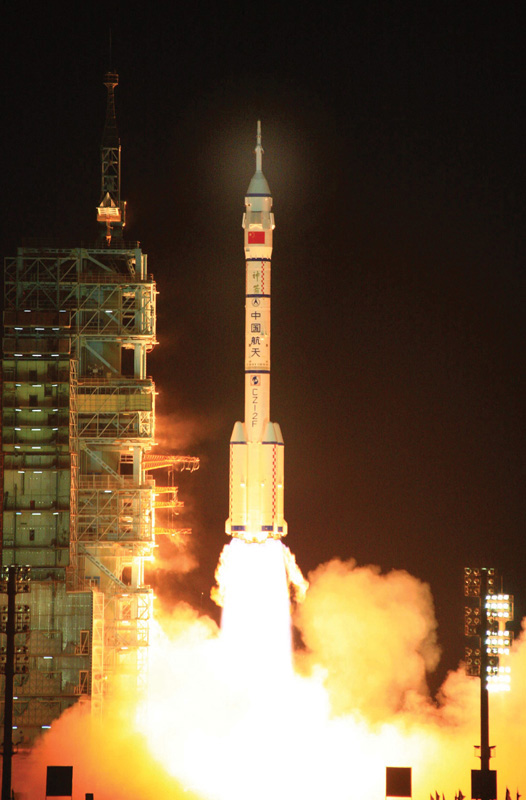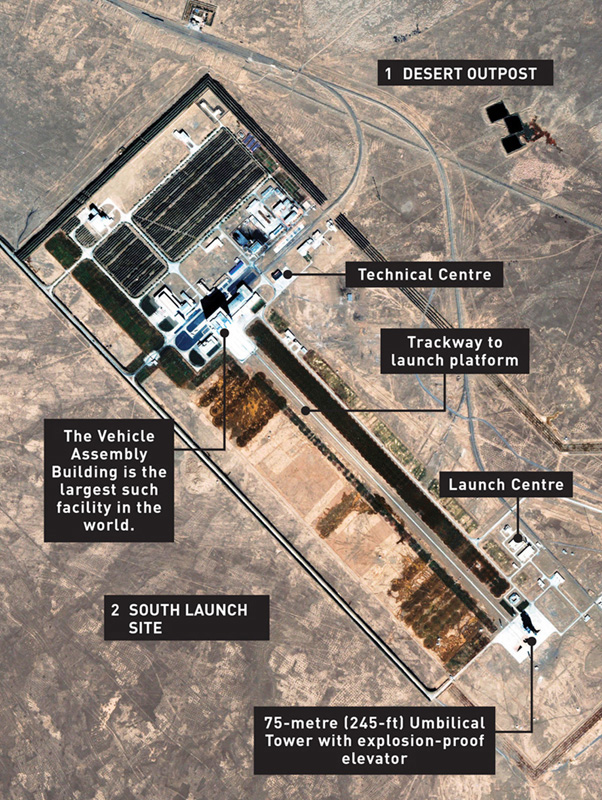
86 Jiuquan Satellite Launch Center
LOCATION Borders of Gansu Province and Inner Mongolia, China
NEAREST POPULATION HUB Jiuquan
SECRECY OVERVIEW Operations classified: secretive center of China’s space program.
In 2003, Yang Liwei became the first man launched into orbit by China. When he took off from the Jiuquan Launch Center, China became only the third country to manage the feat. Largely hidden from the glare of attention in its isolated desert location, the Center’s South launch site is the focus of the nation’s space program. However, much of the huge complex remains off-bounds to outside observers.
Construction of a rocket facility at Jiuquan began in 1958, with assistance from the Soviet Union. In its early years, Jiuquan’s principal purpose was to test launch surface-to-surface and surface-to-air missiles, a fact that greatly disturbed Washington when it became aware of the facility in 1963. Originally known as Base 20, it was China’s chief site for missile development and testing until at least 1980. This work was largely carried out at what is known as the North Launch Site, a facility that was officially decommissioned in 1996.
The South Launch Site, with its 105-meter (344-ft) launch tower, sprouted from the sands of the Gobi Desert in the 1990s to serve as the headquarters of China’s expanding space program. The region’s weather conditions ensure that launches are possible for around 80 percent of the year, while the isolated location reduces the risk of failed rockets falling back to Earth over populated areas. Jiuquan saw its first launch at the end of the decade, and in 2003 came Yang Liwei’s momentous mission, designated Shenzhou 5. After orbiting the planet 14 times, the first “taikonaut” returned to terra firma to find himself a popular hero and Jiuquan firmly fixed in the national consciousness.
Just as the space race had been for the Cold War superpowers of the USA and the USSR in the second half of the 20th century, space exploration for booming 21st-century China is not simply about pushing back the boundaries of science. Perhaps just as important is the role a space program can have in establishing China’s credentials as a new superpower (particularly when its only rival to such a status, the US, has recently struggled to find the dollars to fund its own missions).
Such ambitions have been fermenting for a long time. For instance, Deng Xiaopeng, the country’s de facto leader from 1978–92, is reported to have remarked: “If China had not developed a nuclear bomb and had not launched a satellite, then China would not be able to call itself a great power.”
A second manned mission, Shenzhou 6, was launched from Jiuquan in 2005, this time sending up two taikonauts. Shenzhou 7 followed in 2008, and took the project another step by incorporating extra-vehicular activity (a space-walk, in layman’s terms). While the American and Soviet pioneers of the space race tested each new stage of development with frequent multiple missions, the Chinese approach is more sporadic, but each new mission, when it comes, involves another giant leap forward. Ultimately, China makes no secret of its ambitions to put a permanent manned station into orbit, to establish a base on the Moon, and perhaps even to send a manned mission to Mars.

BLAST OFF A Long-March II-F carrier rocket launches from Jiuquan on September 25, 2008, carrying the Shenzhou 7 spacecraft. This was China’s third manned space mission, sending a crew of three into orbit. Controversy ensued when Shenzhou passed within just 45 km (28 miles) of the International Space Station.
In gestures largely uncharacteristic of Beijing, international journalists have been occasionally invited to share in the state-of-the art work going on at Jiuquan—or at least, they have been invited to see certain specified areas such as the South Launch Site and Donfeng Space City, which is home to several tens of thousands of employees (both military and scientific) and their families. With modern facilities including schools, cinemas, beauty parlors and fast-food joints, one could almost be forgiven for thinking that the entire project is some sort of elaborate space theme park, and indeed, even tightly controlled tourist groups have been welcomed into certain corners of Jiuquan. The Chinese space program, it seems, operates with unusual openness.
Yet the fear remains that there is more going on at Jiuquan than simply space exploration. The Center is a vast operation, with a footprint of some 2,800 square kilometers (1,100 square miles) and its own railway that links to the national network. While the South Site serves to highlight mankind’s continuing determination to become masters of the universe, what goes on elsewhere at the Center is rather more mysterious. Much of it is closed to visitors, with military personnel patrolling to ensure that its exclusion zones are not breached. Those parts where prying eyes are not welcome are said to include an airbase, radar tracking stations and missile testing ranges still in operation. As the US and the Soviet Union discovered, space technology throws up a lot of “transferable” science, and many observers believe that Jiuquan’s role in China’s military endeavors may well turn out to be as important as its more widely heralded space projects.

1 DESERT OUTPOST An overhead view of the Jiuquan Satellite Launch Center, the beating heart of the fast-expanding Chinese space program. The image was captured by the IKONOS observation satellite, the first commercial satellite to collect data at 1-meter (40-in) resolution.
2 SOUTH LAUNCH SITE Jiuquan’s Launch Area 4, operational since 1999, incorporates a Vehicle Assembly Building with twin 82-meter (268-ft) tall assembly halls. Completed rockets travel 1.5 kilometers (0.9 miles) to the launch pad’s Umbilical Tower on a mobile launch platform.